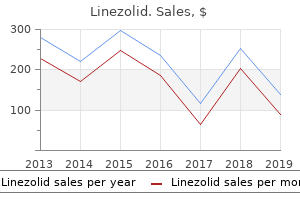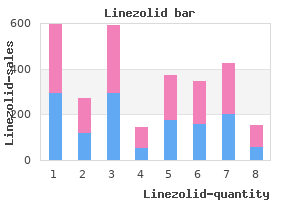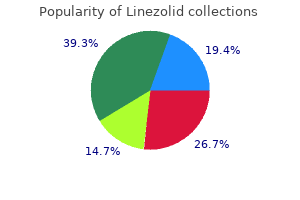"Generic linezolid 600 mg otc, virus - zippy."
By: Joseph A. Smith, Jr., MD
- Professor of Urologic Surgery, Vanderbilt University, Nashville, Tennessee
Complementary methods to antibiotics for treatment of uti in pregnancy purchase linezolid 600mg with visa reduce phlebotomy losses and the use of conservative standardized transfusion standards have contributed to antibiotic resistant superbugs purchase 600 mg linezolid with visa important reductions in transfusions virus 7g7 part 0 buy discount linezolid 600 mg on line. Association of Necrotizing Enterocolitis with anemia and packed red blood transfusions in preterm infants antibiotic names starting with z purchase linezolid 600 mg overnight delivery. A randomized trial to develop standards for administering erythrocyte transfusions to anemic preterm infants 1 to three months of age. Role of leukocyte depletion in the prevention of transfusion-induced cytomegalovirus infection. American Academy of Pediatrics Committee on Nutrition: Iron-fortified toddler formulas. Feeding iron-fortified premature formula during initial hospitalization to infants less than 1800 grams delivery weight. Recombinant human erythropoietin stimulates erythropoiesis and reduces erythrocyte transfusions in very low delivery weight preterm infants. The impact of epoetin beta (recombinant human erythropoietin) on the need for transfusion in very low delivery weight infants. In which neonates does early recombinant human erythropoietin remedy stop anemia of prematurity? Early erythropoietin for stopping red blood cell transfusion in preterm and/or low delivery weight infants. If these events happen in the cerebral cortex, kidneys, or adrenal glands, important damage may outcome. Hematocrit measurements differ greatly with website of pattern, and capillary hematocrit could also be up to 20% higher than venous (2). The imply venous hematocrit of term infants is 53% in wire blood, 60% at 2 hours of age, 57% at 6 hours of age, and 52% at 12 to 18 hours of age (2). Hyperviscosity is defined as viscosity 2 normal deviations higher than the imply (three). Blood viscosity, as described by Poiseuille, is the ratio of shear stress to shear rate and is dependent on such factors as the stress gradient along the vessel, radius, length, and flow (four). The relationship between hematocrit and viscosity is sort of linear beneath a hematocrit of 60%, however viscosity will increase exponentially at a hematocrit of 70% or higher (Figure forty six. Other factors have an effect on blood viscosity, including plasma proteins such as fibrinogen, local blood flow, and pH (three,four). The hyperviscosity syndrome is often seen only in infants with venous hematocrits above 60%. When the wire is clamped within 1 minute after delivery, the blood quantity of the toddler is roughly eighty mL/kg. When the wire is clamped 2 minutes after delivery, the blood quantity of the toddler is 90 mL/kg. In newborns with polycythemia, blood quantity per kilogram of physique weight varies inversely in relation to delivery weight (see Figure forty six. Maternal-to-fetal transfusion is recognized with the Kleihauer-Betke stain strategy of acid elution to detect maternal cells in the circulation of the newborn (see Chap. Placental insufficiency (elevated fetal erythropoiesis secondary to persistent intrauterine hypoxia) 1. Infants with congenital adrenal hyperplasia, Beckwith-Wiedemann syndrome, neonatal thyrotoxicosis, congenital hypothyroidism, trisomy 21, trisomy 13, trisomy 18. Clinical symptoms, syndromes, and laboratory abnormalities which were described in association with polycythemia embrace the following: A. Poor feeding, lethargy, hypotonia, apnea, tremors, jitteriness, seizures, cerebral venous thrombosis. Cyanosis, tachypnea, coronary heart murmur, congestive coronary heart failure, cardiomegaly, elevated pulmonary vascular resistance, prominent vascular markings on chest x-ray. Decreased glomerular filtration, decreased sodium excretion, renal vein thrombosis, hematuria, proteinuria. All of those symptoms could also be related to polycythemia and hyperviscosity however will not be caused by it. The routine screening of all newborns for polycythemia and/or hyperviscosity has been advocated by some authors (8,9).

Which aggressive neuromuscular blocking agent could be used in sufferers with renal failure? Indicate the nondepolarizing agent antimicrobial on air filters studies about buy 600 mg linezolid fast delivery, which has quick duration of motion: a) Succinylcholine b) Tubocurarine c) Mivacurium d) Pancuronium 051 nosocomial infection order linezolid 600 mg free shipping. Neuromuscular blockade by each succinylcholine and mivacurium may be extended in sufferers with: a) Renal failure b) An irregular variant of plasma cholinesterase c) Hepatic illness d) Both b and c 053 antimicrobial jersey effective 600mg linezolid. Which of the next neuromuscular blockers causes transient muscle fasciculations? Indicate muscles infection lining of lungs buy 600mg linezolid fast delivery, which are extra proof against block and get well extra quickly: a) Hand b) Leg c) Neck d) Diaphragm 056. Which neuromuscular blocking agent has the potential to cause the best launch of histamine? Indicate the neuromuscular blocker, which causes tachycardia: a) Tubocurarine b) Atracurium c) Pancuronium d) Succinylcholine 059. Indicate the next neuromuscular blocker, which would be contraindicated in sufferers with renal failure: a) Pipecuronium b) Succinylcholine c) Atracurium d) Rapacuronium 063. Which of the next diseases can increase the neuromuscular blockade produced by nondepolarizing muscle relaxants? Sympathetic stimulation is mediated by: a) Release of norepinephrine from nerve terminals b) Activation of adrenoreceptors on postsynaptic websites c) Release of epinephrine from the adrenal medulla d) All of the above 002. Epinephrine decreases intracellular camp levels by performing on: a) 1 receptor b) 2 receptor c) beta1 receptor d) beta2 receptor 007. Direct results on the center are decided largely by: a) Alfa1 receptor b) Alfa2 receptor c) Beta1 receptor d) Beta2 receptor 009. Which of the next results is expounded to direct beta1-adrenoreceptor stimulation? Distribution of alfa adrenoreceptor subtypes is associated with the entire following tissues except these of: a) Heart b) Blood vessels c) Prostate d) Pupillary dilator muscle 011. In which of the next tissues each alfa and beta1 adrenergic stimulation produces the identical impact? The results of sympathomimetics on blood pressure are associated with their results on: a) the center b) the peripheral resistance c) the venous return d) All of the above 014. A bronchial clean muscle contains: a) lfa1 receptor b) lfa2 receptor c) Beta 1 receptor 26 d) Beta 2 receptor 018. Which of the next drugs causes bronchodilation with out significant cardiac stimulation? Hyperglycemia induced by epinephrine is because of: a) Gluconeogenesis (beta2) b) Inhibition of insulin secretion (alfa) c) Stimulation of glycogenolysis (beta2) d) All of the above 024. Indicate the drug, which is a direct-performing each alfa- and beta-receptor agonist: a) Norepinephrine b) Methoxamine c) Isoproterenol d) Ephedrine 027. Indicate the direct-performing sympathomimetic, which is an alfa1 alfa2 beta1 receptor agonist: a) Isoproterenol b) Ephedrine c) Dobutamine d) Norepinephrine 029. Indicate the alfa2-selective agonist: a) Xylometazoline b) Epinephrine c) Dobutamine d) Methoxamine 031. Indicate the beta1-selective agonist: a) Isoproterenol b) Dobutamine c) Metaproterenol d) Epinephrine 033. Indicate the indirect-performing sympathomimetic agent: a) Epinephrine b) Phenylephrine c) Ephedrine d) Isoproterenol 035. Norepinephrine produces: a) Vasoconstriction b) Vasodilatation c) Bronchodilation d) Decresed potassium concentration within the plasma 040. Which of the next direct-performing drugs is a comparatively pure alfa agonist, an effective mydriatic and decongestant and can be used to increase blood pressure? Which of the next agents is an alfa2-selective agonist with ability to promote constriction of the nasal mucosa? Indicate the sympathomimetic, which may cause hypotension, presumably due to a clonidine-like impact: a) Methoxamine b) Phenylephrine c) Xylometazoline d) Isoproterenol 044. Isoproterenol is: a) Both an alfa- and beta-receptor agonist b) beta1-selective agonist c) beta2-selective agonist d) Nonselective beta receptor agonist 045. Which of the next sympathomimetics is preferable for the treatment of chronic orthostatic hypotension? Indicate the sympathomimetic drug, which is used in a hypotensive emergency: a) Xylometazoline b) Ephedrine c) Terbutaline d) Phenylephrine 053.
Buy linezolid 600 mg with visa. Concierge Collection 100% Cotton Sheet and Blanket Combo.

The wire is stabilized with a forceps or hemostat virus 68 affecting children cheap linezolid 600mg fast delivery, and the two arteries are identified antibiotic and birth control cheap 600mg linezolid otc. The open tip of an iris forceps is inserted into the artery lumen and gently used to antibiotics for uti without sulfa 600 mg linezolid visa dilate the vessel; after which the closed tip is inserted into the lumen of an artery to infection game plague inc discount 600mg linezolid amex a depth of 0. Tension on the forceps tip is released, and the forceps is left in place to dilate the vessel for approximately 1 minute. A barely increased resistance might be felt as the catheter passes via the base of the wire and because it navigates the umbilical artery�femoral artery junction. Sometimes, a double-catheter method will permit profitable cannulation in this situation, particularly if the primary catheter has made a false monitor and is not in the lumen of the umbilical artery. Leave the original catheter in place and gently pass a second catheter alongside side it. The catheter might pass into the aorta however then loop caudad again down the contralateral iliac artery or out in one of the arteries to the buttocks. There could also be issue in advancing the catheter and cyanosis or blanching of the leg or buttocks might happen. Sometimes, utilizing a larger, stiffer catheter (5 Fr) will permit the catheter to advance up the aorta. Alternatively, retracting the catheter into the umbilical artery, rotating it, and readvancing it into the aorta might result in aortic placement. If this fails, the catheter should be removed and placement tried via the other umbilical artery. When the catheter is superior, the appropriate distance and placement should be confirmed by radiographic examination. The catheter should be fastened in place with a handbag-string suture utilizing silk thread, and a tape bridge added for further stability (see Chap. The umbilical artery catheter should be removed when both of the following criteria is met. The toddler improves such that continuous monitoring and frequent blood drawings are not essential. The catheter is removed slowly over a interval of 30 to 60 seconds, permitting the umbilical artery to constrict at its proximal finish whereas the catheter is still occluding the distal finish. If bleeding should happen despite this technique, strain should be held at the stump of the umbilical artery till the bleeding ceases. Significant morbidity can be associated with issues of umbilical artery catheterization. These issues are primarily because of vascular accidents, together with thromboembolic phenomena to the kidney, bowel, legs, or not often the spinal wire. These might manifest as hematuria, hypertension, indicators of necrotizing enterocolitis or bowel infarction, and cyanosis or blanching of the skin of the again, buttocks, or legs. Other issues seen are an infection, disseminated intravascular coagulation, and vessel perforation. Close observation of the skin, monitoring of the urine for hematuria, measuring blood strain, and following the platelet count might give clues to issues. If there are small thrombi with out signs or with increased blood strain alone, we often remove the catheter, follow the resolution of the thrombi by ultrasonographic examination, and treat hypertension if essential (see Chap. Blanching of a leg following catheter placement is the commonest complication famous clinically. A higher complication rate has been reported in infants with the catheter tip at L3 to L4, in contrast with T6 to T10, owing to extra episodes of blanching and cyanosis of 1 or each legs. No difference between the excessive- and low-place teams was seen in the rate of issues requiring catheter removal. Renal issues and emboli to the bowel could also be extra common with catheter tips positioned at T6 to T10 whereas catheters positioned low (L3�L4) are Common Neonatal Procedures 865 associated with issues such as cyanosis and blanching of the leg, which are simpler to observe. The incidence of issues associated with umbilical artery catheterization seems to be instantly associated to the size of time the catheter is left in place. The need for the catheter should be reassessed every day, and the catheter should be removed as soon as attainable.

The lower arm paralysis affects the intrinsic muscle tissue of the hand and the lengthy flexors of the wrist and fingers antibiotic resistance doxycycline buy 600mg linezolid. Because the first thoracic root is usually injured antibiotics nitrofurantoin generic linezolid 600mg on line, its sympathetic fibers are broken infection from cat scratch generic linezolid 600 mg, leading to antibiotic 93 3147 generic linezolid 600 mg overnight delivery an ipsilateral Horner syndrome. Injury of the clavicle, higher humerus, and lower cervical backbone might mimic a brachial plexus harm. Radiographs of the shoulder and higher arm must be carried out to rule out bony harm. These must be started at 7 to 10 days, when the postinjury neuritis has resolved. If the nerve roots are intact and never avulsed, the prognosis for full recovery is superb (90%). Notable medical improvement in the first 2 weeks after birth indicates that normal or close to-normal operate will return. In those with gradual recovery, electromyography and nerve-conduction studies might distinguish an avulsion from a stretch harm. Clavicular fracture is the most commonly injured bone during supply, occurring in up to 3% of newborns. These fractures are seen in vertex shows with shoulder dystocia or in breech deliveries when the arms are extended. Differential diagnosis includes fracture of the humerus or a brachial plexus palsy. If the arm movement is decreased, the cervical backbone, brachial plexus, and humerus must be assessed. Assessment and Treatment in the Immediate Postnatal Period 71 Therapy must be directed at decreasing ache with analgesics. Humeral fractures typically happen during a troublesome supply of the arms in the breech presentation and/or of the shoulders in vertex. The first sign is typically loss of spontaneous arm movement, followed by swelling and ache on passive motion. In some cases, the harm is probably not famous for a couple of days till swelling, decreased movement, or ache with palpation develop. Pain and tenderness with palpation are more likely with epiphyseal separation than dislocation. Macrosomia, hepatomegaly, and breech presentation are risk factors for hepatic hematoma and/or rupture. Rupture of the hematoma by way of the capsule leads to discoloration of the belly wall and circulatory collapse with shock. Management includes restoration of blood volume, correction of coagulation disturbances, and surgical consultation for probable laparotomy. Risk factors for splenic harm embody macrosomia, breech supply, and splenomegaly. A mass is usually palpable in the left higher quadrant, and the abdomen bubble could also be displaced medially on an belly radiograph. Expectant management with close remark is suitable if the bleeding has stopped and the patient has stabilized. If laparotomy is necessary, salvage of the spleen is attempted to minimize the risk of sepsis. Adrenal insufficiency might present with poor feeding, vomiting, irritability, listlessness, and shock. The birth historical past, location of lesions, their early appearance with out improvement of recent lesions, and the absence of bleeding from other sites help differentiate petechiae and ecchymoses secondary to birth trauma from those attributable to a vasculitis or coagulation dysfunction. If the etiology is unsure, studies to rule out coagulopathies and infection must be carried out. Lacerations and abrasions could also be secondary to scalp electrodes and fetal scalp blood sampling or harm during birth. Infection is a risk, particularly with scalp lesions and an underlying caput succedaneum or hematoma. It usually presents through the first 2 weeks after birth as sharply demarcated; irregularly formed; agency; and nonpitting subcutaneous plaques or nodules on the extremities, face, trunk, or buttocks. The High-Risk Newborn: Anticipation, Evaluation, Management, and Outcome Vincent C.
References:
- https://ocw.mit.edu/courses/health-sciences-and-technology/hst-021-musculoskeletal-pathophysiology-january-iap-2006/lecture-notes/hms_7204_lect1_2.pdf
- https://www.rmhpcommunity.org/sites/default/files/resource/PCBH%20Implementation%20Kit_FINAL.pdf
- https://www.hca.wa.gov/assets/program/neuro_final_report_120513[1].pdf

